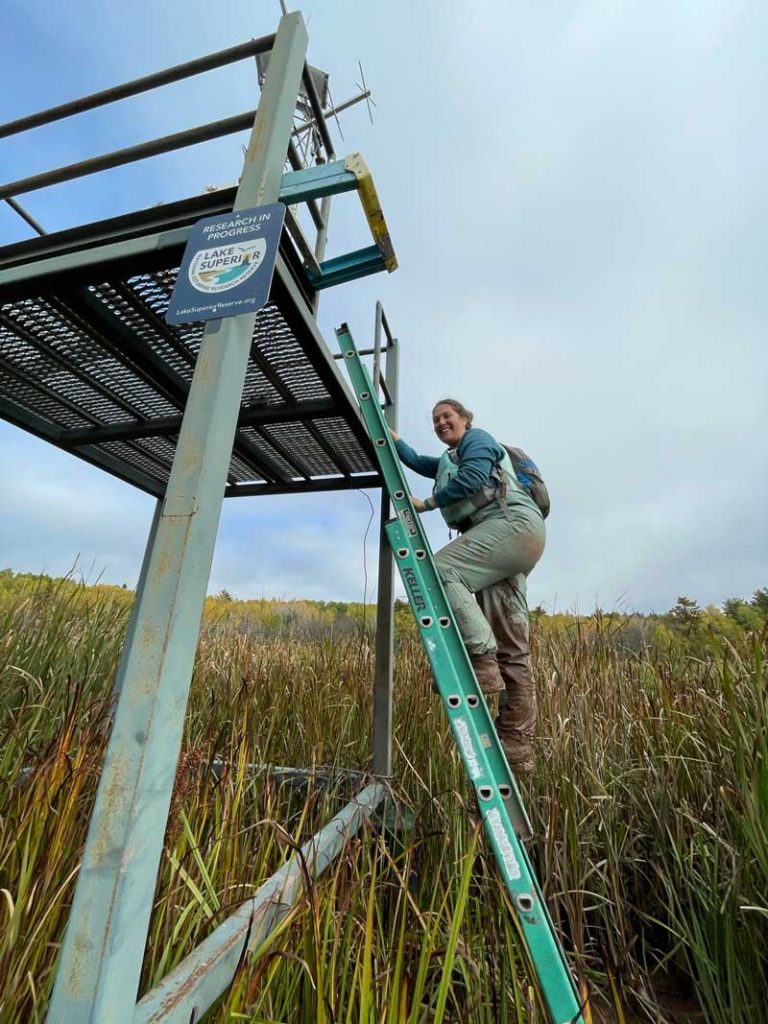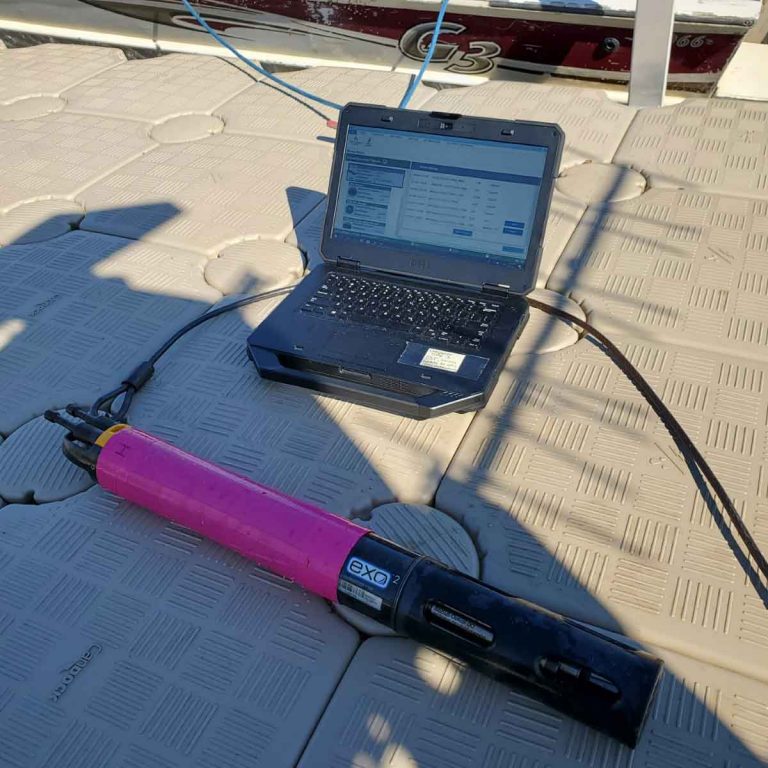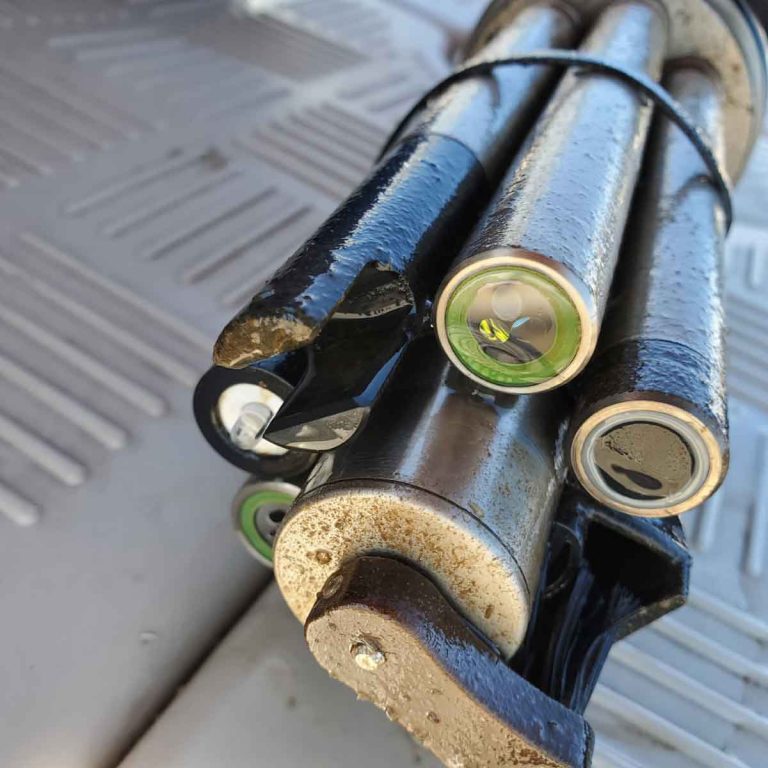
As the monitoring coordinator for the Lake Superior National Estuarine Research Reserve (LSNERR), Hannah Ramage spends a lot of time collecting data on the water and habitat quality in the St. Louis River estuary. In the warm months, it’s waders and canoes; in the cold months, it’s data analysis and quality assurance. And because she oversees the calibration and deployment of equipment in the field, there’s also a bit of MacGyvering.
“A lot of my job is finding the right hardware to attach sensors to things.”
As one of 29 reserves in the National Estuarine Research Reserve System, LSNERR is charged with collecting data on the weather, water and habitat of the St. Louis River estuary. Each reserve follows standardized protocol to ensure that data are comparable across the entire system. Ramage explains that this protocol allows researchers to identify trends over time and check in with current water conditions.
“You have a snapshot at any given time of the health of our estuaries in the country.”
One of the tools that Ramage and research interns use to collect data is the water quality sonde, an underwater computer that takes measurements every fifteen minutes. Ramage notes that, at first glance, the sonde doesn’t look like much. “It’s about a meter long and two thirds of it are really boring. It’s just a plastic tube.” This part holds the big batteries needed to power the sonde while submerged in water for up to a month.
On the other end of the sonde is where the magic happens. “The sensor end of it is all these metal, shiny sensors, many of which emit light.” The sensors measure things like pH, temperature and how much dissolved oxygen is in the water—data that are all made available to the public.
“Anyone from third-graders doing a cool science experiment to researchers at the EPA to natural resource managers can have that data and know that it’s quality and use it.”
Tackling total algae abundance
This year, Ramage and her colleagues across the Reserve system are investigating whether to add a new instrument to their data-collecting toolkit: a total algae sensor. The hope, Ramage says, is that the sensor will be able to identify when there is more algae in the water, and ultimately, help predict blooms. “There isn’t anything super effective right now in this system that would say there might be an algal bloom or one happening soon.”
Specifically, the team is working to identify how well the sensor measures actual algae abundance in water. Factors like temperature, dissolved organic carbon and the cloudiness of the water may skew readings.
“The total algae sensor works with light,” Ramage says, “so anything that can interfere with light is on the suspect list.”
The team is hoping to model out these interferences and produce accurate and reliable readings of total algae abundance. A sensor could then be placed on a sonde with telemetry, which reports water conditions every hour.
“If we can have next to real-time sensor data that might be able to indicate an algal bloom,” Ramage says, “that would be really beneficial.”
Lacking real-time monitoring technology means humans must sound the alarm when waters start looking green—something Ramage has done as recently as this fall. On September 20, 2021, while driving across a bridge spanning the St. Louis River, she spotted a green, paint-like slick near Barkers Island Beach. Suspecting a bloom, she snapped a few photos and collected a water sample to be sent to a lab for analysis.
The results returned several days later: three species of blue-green algae and toxins at unsafe levels.
The findings made the news. Wisconsin Public Radio and the Chicago Tribune both reported on the story and discussed the bloom in context of those occurring with greater frequency in Lake Superior—an alarming trend for a lake known for its crystal clear waters.
Ramage emphasizes, however, that the bloom she captured in the estuary is different from those occurring in Lake Superior proper, the causes of which are poorly understood.
“This wasn’t a lake bloom. The blooms that are happening in Lake Superior are mostly a species that thrives in nutrient-poor water.” The waters surrounding Barkers Island Beach, on the other hand, are more nutrient-rich.
Still, the estuary and lake are connected, and the presence of blooms in both underlines the importance of identifying tools that can help researchers understand the blooms better.
“Here on Lake Superior, everything is so novel, and we know so little that it’s like adjusting and tweaking those tools [from] how they’ve been used in other places to see if they work here.”
Winter is coming
Wintertime is data analysis time, and Ramage has big plans for the coming months. She’ll be delving into the total algae sensor data with a team of colleagues from 13 other reserves to make a recommendation about adopting the sensor. She’s hopeful.
“I feel like it’s promising that we should be able to make a strong recommendation to the system to start adopting the sensors in one way or another.”
This winter also marks nine years of collecting weather, water and habitat data in the estuary, and Ramage is jazzed. Nine is a magic number.
“Nine years is about the length where we can finally start to look at some trends over that time. It’s the minimum amount of data you need to do some statistical analysis.”
In the world of grant-funded projects with defined timelines, Ramage says that it’s rare to have long-term monitoring data like this. “We’re just on the cusp of big data, long-term analysis potential.” Ramage will then start working with her colleagues to communicate what they learn from the data with the community.
She cites intriguing data points she’s already noticed from the dataset and laughs. “I’m excited for winter because I can finally close my door and lock myself in my office and dig into some of these things!”
To learn more about the Lake Superior National Estuarine Research Reserve or view the real-time weather data in the estuary, check out their website.







